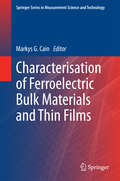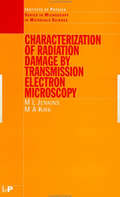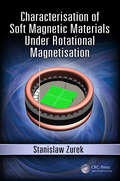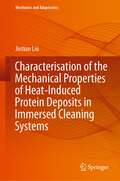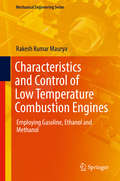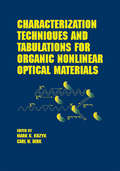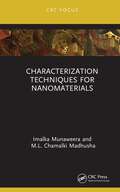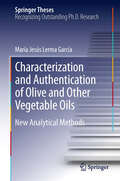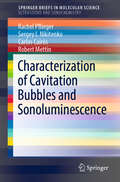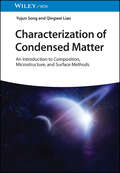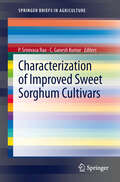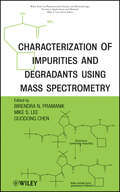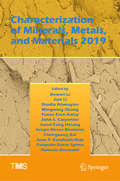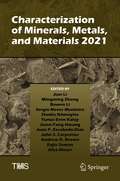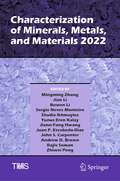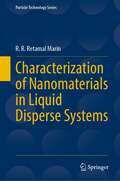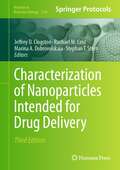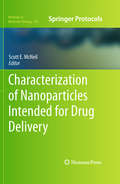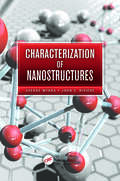- Table View
- List View
Characterisation of Ferroelectric Bulk Materials and Thin Films: Solutions For Metrology (Springer Series in Measurement Science and Technology #2)
by Markys G. CainThis book presents a comprehensive review of the most important methods used in the characterisation of piezoelectric, ferroelectric and pyroelectric materials. It covers techniques for the analysis of bulk materials and thick and thin film materials and devices. There is a growing demand by industry to adapt and integrate piezoelectric materials into ever smaller devices and structures. Such applications development requires the joint development of reliable, robust, accurate and - most importantly - relevant and applicable measurement and characterisation methods and models. In the past few years there has been a rapid development of new techniques to model and measure the variety of properties that are deemed important for applications development engineers and scientists. The book has been written by the leaders in the field and many chapters represent established measurement best practice, with a strong emphasis on application of the methods via worked examples and detailed experimental procedural descriptions. Each chapter contains numerous diagrams, images, and measurement data, all of which are fully referenced and indexed. The book is intended to occupy space in the research or technical lab, and will be a valuable and practical resource for students, materials scientists, engineers, and lab technicians.
Characterisation of Radiation Damage by Transmission Electron Microscopy (Series in Microscopy in Materials Science)
by M.L Jenkins M.A KirkCharacterization of Radiation Damage by Transmission Electron Microscopy details the electron microscopy methods used to investigate complex and fine-scale microstructures, such as those produced by fast-particle irradiation of metals or ion implantation of semiconductors. The book focuses on the methods used to characterize small point-defect clus
Characterisation of Soft Magnetic Materials Under Rotational Magnetisation
by Stanislaw ZurekThe book presents practical aspects related to the measurement of rotational power loss in soft magnetic materials. The book furthermore focuses on practical aspects of performing such measurements, the associated difficulties as well as solutions to the most common problems. Numerous practical aspects, hands-on experience, and most commonly encountered pitfalls are heavily discussed in the book. The text begins with introduction to magnetism, then follows with definitions of measurement methods of rotational power loss from physical viewpoint. Two chapters describe and detail the various sensors which can be employed for such measurements as well as all the aspects of designing, making, and using a magnetising apparatus. A synthesis of the likely optimal design of a magnetising apparatus is also given, preceded with the full reasoning based on all the research carried out to date. <P><P>Characterisation of Soft Magnetic Materials Under Rotational Magnetisation serves as an excellent starting point for any student having to perform magnetic measurements under rotational magnetisation, but also under 1D, 2D or 3D excitation. Because the methods, sensors, and apparatus are extensively discussed it will also be a great reference for more senior researchers and experts in the field. There is a whole chapter devoted to analysis of measurement uncertainty. This subject is rarely published for magnetic measurements, which makes it more difficult for all researchers to understand the concepts and methodology used in uncertainty estimation. This chapter not only introduces the whole subject, but also provides multiple step-by-step examples which can be easily followed, from very simple cases to much more complex ones. All equations are presented with full SI units which greatly helps in practical application of the presented methodology. Each chapter is written in such a way that it can be studied on its own, so that the reader can focus only on the specific aspects, as required.
Characterisation of Turbulent Duct Flows: Experiments and Direct Numerical Simulations (Springer Theses)
by Bayode OwolabiThis book presents several new findings in the field of turbulent duct flows, which are important for a range of industrial applications. It presents both high-quality experiments and cutting-edge numerical simulations, providing a level of insight and rigour rarely found in PhD theses. The scientific advancements concern the effect of the Earth’s rotation on large duct flows, the experimental confirmation of marginal turbulence in a pressure-driven square duct flow (previously only predicted in simulations), the identification of similar marginal turbulence in wall-driven flows using simulations (for the first time by any means) and, on a separate but related topic, a comprehensive experimental study on the phenomenon of drag reduction via polymer additives in turbulent duct flows. In turn, the work on drag reduction resulted in a correlation that provides a quantitative prediction of drag reduction based on a single, measurable material property of the polymer solution, regardless of the flow geometry or concentration. The first correlation of its kind, it represents an important advancement from both a scientific and practical perspective.
Characterisation of the Mechanical Properties of Heat-Induced Protein Deposits in Immersed Cleaning Systems (Mechanics and Adaptronics)
by Jintian LiuDuring heat treatment in dairy production, the rapid formation of heat-induced fouling deposits on the plant surface leads to reduced efficiency of heat transfer. Therefore, a regular cleaning process is required to soften the heat-induced protein deposits and then remove them from the plant surface. The mechanical property of the deposits is one of the key issues of the cleaning mechanisms since the non-fractured behaviour dominates the deformation of the fouling layer and the failure behaviour has a great impact on the cohesive removal of fouling deposits. Considering the complicated geometry of fouling deposits and their irregular distribution, indentation experiments were carried out on various kinds of protein deposits. The experimental results reveal the significant influence of the thickness of fouling deposits on their mechanical behaviour and the time-dependent nonlinear behaviour of the deposits.Furthermore, heat-induced whey protein gel was used as the model material for fouling deposits and the non-fractured and fracture behaviour was characterized using compression and wire cutting experiments, respectively. The material parameters identified using the inverse finite element method allow the prediction of fracture behaviour under localized external loads and provide a deeper insight into cohesive removal. To investigate the softening effect during caustic washing, tensile experiments were conducted on chemically treated and untreated whey protein gels. Adequate chemical degradation leads to a softer mechanical response and increased stress relaxation, making whey protein gels more flowable and more resistant to tensile deformation. The experimental results provide useful data on the failure behaviour of chemically treated whey protein gels.
Characteristics and Control of Low Temperature Combustion Engines: Employing Gasoline, Ethanol and Methanol (Mechanical Engineering Series)
by Rakesh Kumar MauryaThis book deals with novel advanced engine combustion technologies having potential of high fuel conversion efficiency along with ultralow NOx and particulate matter (PM) emissions. It offers insight into advanced combustion modes for efficient utilization of gasoline like fuels. Fundamentals of various advanced low temperature combustion (LTC) systems such as HCCI, PCCI, PPC and RCCI engines and their fuel quality requirements are also discussed. Detailed performance, combustion and emissions characteristics of futuristic engine technologies such as PPC and RCCI employing conventional as well as alternative fuels are analyzed and discussed. Special emphasis is placed on soot particle number emission characterization, high load limiting constraints, and fuel effects on combustion characteristics in LTC engines. For closed loop combustion control of LTC engines, sensors, actuators and control strategies are also discussed. The book should prove useful to a broad audience, including graduate students, researchers, and professionals.
Characterization Techniques and Tabulations for Organic Nonlinear Optical Materials (Optical Science And Engineering Ser. #60)
by Kuzyk""Furnishes table of nonlinear optical properties of organic substances as well as experimental procedures for measuring the nonlinearity of the elements tabulated, including composite materials-offering support for scientists and engineers involved in characterizing, optimizing, and producing materials for manufacturing optical devices.
Characterization Techniques for Nanomaterials
by Imalka Munaweera M.L. Chamalki MadhushaManipulation of matter at the nanoscale level is the key factor in nanotechnology, and it is considered as a great driving force behind the current industrial revolution since it offers facile and feasible remedies for many problems. Because of the unique characteristic properties of nanomaterials, they can be employed in a wide variety of fields such as agriculture and food technology, catalysis, biomedical applications, tissue culture engineering and fertilizers, etc. In this regard, characterization of nanomaterials plays a significant role in determining their optical, thermal, and physicochemical properties. Many techniques have been used in nanomaterial characterization and the most important techniques are discussed in detail in this book with its principles, basic operation procedures and applications with suitable examples. In summary, this book offers a broad content on the most important chemical and structural characterization techniques of nanomaterials. The book offers comprehensive coverage of the most essential topics, including: Provides a comprehensive understanding about physical and chemical characterization techniques of nanomaterials Includes details about basic principles of each characterization technique with appropriate examples Covers most of the important characterization techniques that need to know under the level of undergraduate/early career scientists/beginners in materials chemistry Provides all the basic knowledge to understand and carry out the respective analysis of nanomaterials Fulfills the timely need of a book that covers the most important and useful characterization techniques in nanomaterial characterization Up to date, there are no other books/book chapters which discuss most of these nanocharacterization techniques in one segment with all the basic instrumentation details and narrated examples of nanomaterial characterization. In a nutshell, this book will be a great asset to undergraduates/early career scientists/beginners of material science since it provides a comprehensive and complete understanding about most of the techniques nanocharacterization tools in a short time. Intended audience is based on science education while specifically focusing on undergraduates/graduate students/early scientists and beginners of chemistry, materials chemistry and nanotechnology and nanoscience.
Characterization and Authentication of Olive and Other Vegetable Oils: New Analytical Methods (Springer Theses)
by María Jesús Lerma GarcíaThis thesis presents new methods for the characterization of vegetable oils, with focus in olive oil, according to geographical and botanical origin, genetic variety and other issues influencing product quality. A wide variety of analytical techniques have been employed, such as various chromatographic techniques (different gas and liquid chromatography methods), an electronic nose, infrared spectroscopy and expert-panel evaluation. Several families of minor compounds, with interest as adulteration markers, have been used for method development, including tocopherols, sterols, phenolics, alcohols, proteins and others. Most methods have been enhanced by the application of multivariate chemometrics. The proposed analytical techniques are of interest to investigate fraudulent actions and practices which are detrimental to product quality.
Characterization and Modification of Graphene-Based Interfacial Mechanical Behavior (Springer Theses)
by Guorui WangThis thesis shares new findings on the interfacial mechanics of graphene-based materials interacting with rigid/soft substrate and with one another. It presents an experimental platform including various loading modes that allow nanoscale deformation of atomically thin films, and a combination of atomic force microscopy (AFM) and Raman spectroscopy that allows both displacement and strain to be precisely measured at microscale. The thesis argues that the rich interfacial behaviors of graphene are dominated by weak van der Waals force, which can be effectively modulated using chemical strategies. The continuum theories are demonstrated to be applicable to nano-mechanics and can be used to predict key parameters such as shear/friction and adhesion. Addressing key interfacial mechanics issues, the findings in thesis not only offer quantitative insights in the novel features of friction and adhesion to be found only at nanoscale, but will also facilitate the deterministic design of high-performance graphene-based nanodevices and nanocomposites.
Characterization of Cavitation Bubbles and Sonoluminescence (SpringerBriefs in Molecular Science)
by Rachel Pflieger Sergey I. Nikitenko Carlos Cairós Robert MettinThis book presents the latest research on fundamental aspects of acoustic bubbles, and in particular on various complementary ways to characterize them. It starts with the dynamics of a single bubble under ultrasound, and then addresses few-bubble systems and the formation and development of bubble structures, before briefly reviewing work on isolated bubbles in standing acoustic waves (bubble traps) and multibubble systems where translation and interaction of bubbles play a major role. Further, it explores the interaction of bubbles with objects, and highlights non-spherical bubble dynamics and the respective collapse geometries. It also discusses the important link between bubble dynamics and energy focusing in the bubble, leading to sonochemistry and sonoluminescence. The second chapter focuses on the emission of light by cavitation bubbles at collapse (sonoluminescence) and on the information that can be gained by sonoluminescence (SL) spectroscopy, e.g. the conditions reached inside the bubbles or the nature of the excited species formed. This chapter also includes a section on the use of SL intensity measurement under pulsed ultrasound as an indirect way to estimate bubble size and size distribution. Lastly, since one very important feature of cavitation systems is their sonochemical activity, the final chapter presents chemical characterizations, the care that should be taken in using them, and the possible visualization of chemical activity. It also explores the links between bubble dynamics, SL spectroscopy and sonochemical activity. This book provides a fundamental basis for other books in the Molecular Science: Ultrasound and Sonochemistry series that are more focused on applied aspects of sonochemistry. A basic knowledge of the characterization of cavitation bubbles is indispensable for the optimization of sonochemical processes, and as such the book is useful for specialists (researchers, engineers, PhD students etc.) working in the wide area of ultrasonic processing.
Characterization of Condensed Matter: An Introduction to Composition, Microstructure, and Surface Methods
by Yujun Song Qingwei LiaoCharacterization of Condensed Matter A comprehensive and accessible introduction to the characterization of condensed materials The characterization of condensed materials is a crucial aspect of materials science. The science underlying this area of research and analysis is interdisciplinary, combining electromagnetic spectroscopy, surface and interface testing methods, physiochemical analysis methods, and more. All of this must be brought to bear in order to understand the relationship between microstructures and larger-scale properties of condensed matter. Characterization of Condensed Matter: An Introduction to Composition, Microstructure, and Surface Methods introduces the technologies involved in the characterization of condensed matter and their many applications. It incorporates more than a decades’ experience in teaching a successful undergraduate course in the subject and emphasizes accessibility and continuously reinforced learning. The result is a survey which promises to equip students with both underlying theory and real experimental instances of condensed matter characterization. Characterization of Condensed Matter readers will also find: Detailed treatment of techniques including electromagnetic spectroscopy, X-ray diffraction, X-ray absorption, electron microscopy, surface and element analysis, and more Incorporation of concrete experimental examples for each technique Exercises at the end of each chapter to facilitate understanding Characterization of Condensed Matter is a useful reference for undergraduates and early-career graduate students seeking a foundation and reference for these essential techniques.
Characterization of Improved Sweet Sorghum Cultivars (SpringerBriefs in Agriculture)
by C. Ganesh Kumar P. Srinivasa RaoA number of driving forces, including the soaring global crude oil prices and environmental concerns in both developed and developing nations has triggered a renewed interest in the recent years on the R&D of biofuel crops. In this regard, many countries across the globe are investing heavily in the bioenergy sector for R&D to increase their energy security and reduce their dependence on imported fossil fuels. Currently, most of the biofuel requirement is met by sugarcane in Brazil and corn in the United States, while biodiesel from rapeseed oil in Europe. Sweet sorghum has been identified as a unique biofuel feedstock in India since it is well adapted to Indian agro-climatic conditions and more importantly it does not jeopardize food security at the cost of fuel. Sweet sorghum [Sorghum bicolor (L.) Moench] is considered as a SMART new generation energy crop as it can accumulate sugars in its stalks similar to sugarcane, but without food¬¬-fuel trade-offs and can be cultivated in almost all temperate and tropical climatic conditions and has many other advantages. The grain can be harvested from the panicles at maturity. There is no single publication detailing the agronomic and biochemical traits of tropical sweet sorghum cultivars and hybrid parents. Hence, an attempt is made in this publication- "Characterization of improved sweet sorghum cultivars" to detail the complete description of cultivars. This book serves as a ready reference on the detailed characterization of different improved sweet sorghum genotypes following the PPVFRA guidelines for the researchers, entrepreneurs, farmers and other stakeholders to identify the available sweet sorghum cultivars and understand their yield potential in tropics.
Characterization of Impurities and Degradants Using Mass Spectrometry
by Mike S. Lee Guodong Chen Birendra PramanikThe book highlights the current practices and future trends in structural characterization of impurities and degradants. It begins with an overview of mass spectrometry techniques as related to the analysis of impurities and degradants, followed by studies involving characterization of process related impurities (including potential genotoxic impurities), and excipient related impurities in formulated products. Both general practitioners in pharmaceutical research and specialists in analytical chemistry field will benefit from this book that will detail step-by-step approaches and new strategies to solve challenging problems related to pharmaceutical research.
Characterization of Minerals, Metals, and Materials 2019 (The Minerals, Metals & Materials Series)
by Jian Li Jiann-Yang Hwang Shadia Ikhmayies John S. Carpenter Sergio Neves Monteiro Mingming Zhang Bowen Li Juan P. Escobedo-Diaz Chenguang Bai Yunus Eren Kalay Ramasis Goswami Pasquale Russo SpenaThis collection gives broad and up-to-date results in the research and development of materials characterization and processing. Topics covered include characterization methods, ferrous materials, non-ferrous materials, minerals, ceramics, polymer and composites, powders, extraction, microstructure, mechanical behavior, processing, corrosion, welding, solidification, magnetic, electronic, environmental, nano-materials, and advanced materials <p><p> The book explores scientific processes to characterize materials using modern technologies, and focuses on the interrelationships and interdependence among processing, structure, properties, and performance of materials.
Characterization of Minerals, Metals, and Materials 2021 (The Minerals, Metals & Materials Series)
by Jian Li Jiann-Yang Hwang Shadia Ikhmayies John S. Carpenter Sergio Neves Monteiro Mingming Zhang Bowen Li Juan P. Escobedo-Diaz Yunus Eren Kalay Rajiv Soman Andrew D. Brown Alex MoserThe collection focuses on the advancements of characterization of minerals, metals, and materials and the applications of characterization results on the processing of these materials. Advanced characterization methods, techniques, and new instruments are emphasized. Areas of interest include, but are not limited to: · Novel methods and techniques for characterizing materials across a spectrum of systems and processes. · Characterization of mechanical, thermal, electrical, optical, dielectric, magnetic, physical, and other properties of materials. · Characterization of structural, morphological, and topographical natures of materials at micro- and nano- scales. · Characterization of extraction and processing including process development and analysis. · Advances in instrument developments for microstructure analysis and performance evaluation of materials, such as computer tomography (CT), X-ray and neutron diffraction, electron microscopy (SEM, FIB, TEM), and spectroscopy (EDS, WDS, EBSD) techniques. · 2D and 3D modelling for materials characterization. The book explores scientific processes to characterize materials using modern technologies, and focuses on the interrelationships and interdependence among processing, structure, properties, and performance of materials.
Characterization of Minerals, Metals, and Materials 2022 (The Minerals, Metals & Materials Series)
by Jian Li Jiann-Yang Hwang Shadia Ikhmayies John S. Carpenter Sergio Neves Monteiro Mingming Zhang Bowen Li Zhiwei Peng Juan P. Escobedo-Diaz Yunus Eren Kalay Rajiv Soman Andrew D. BrownThe collection focuses on the advancements of characterization of minerals, metals, and materials and the applications of characterization results on the processing of these materials. Advanced characterization methods, techniques, and new instruments are emphasized. Areas of interest include, but are not limited to: • Novel methods and techniques for characterizing materials across a spectrum of systems and processes. • Characterization of mechanical, thermal, electrical, optical, dielectric, magnetic, physical, and other properties of materials. • Characterization of structural, morphological, and topographical natures of materials at micro- and nano- scales. • Characterization of extraction and processing including process development and analysis. • Advances in instrument developments for microstructure analysis and performance evaluation of materials, such as computer tomography (CT), X-ray and neutron diffraction, electron microscopy (SEM, FIB, TEM), and spectroscopy (EDS, WDS, EBSD) techniques. • 2D and 3D modelling for materials characterization.
Characterization of Nanomaterials in Liquid Disperse Systems (Particle Technology Series #28)
by R. R. Retamal MarínThis book describes different aspects of characterization and detection of nanomaterials in liquid disperse systems, such as suspensions, emulsions and suspoemulsions. Natural and technical particulate nanomaterials (NMs) are often present in formulations and products consisting of several disperse phases and complex dispersion media. Specific interfacial properties of the particles, their interactions with each other and with the dispersion medium, have to be considered. For example, the interfacial properties determine whether the particles tend to be arranged in aqueous or lipid phases or at their phase boundaries. The interfacial properties are significantly influenced by the adsorption of dissolved species, i.e., they depend on the composition of the dispersion medium. This poses great challenges for the characterization of these nanoparticle systems and requires adequate preparation methods. The nanoparticle measurement techniques aim at a deep physico-chemical understanding of the dispersity state of nanoparticle systems. Since the dispersity state of nanoparticle systems in an application usually does not correspond to their original manufacturing process, the formulation of new or improved product properties is of decisive importance. The characterization of nanoparticles in complex formulations or matrices requires an adequate sample preparation based on an existing or yet to be developed Standard Operating Procedure (SOP). The structure of the SOPs includes the dispersion regulations, which are of essential importance for comparing reproducible results of nanoparticle measurement with respect to comparability and transferability worldwide. The aim is to separate and isolate relevant NMs with knowledge of the interrelationships.
Characterization of Nanoparticles Intended for Drug Delivery (Methods in Molecular Biology #2789)
by Jeffrey D. Clogston Rachael M. Crist Marina A. Dobrovolskaia Stephan T. SternThis third edition volume expands on the previous editions with new and updated discussions on the latest developments in endotoxin contamination, complex physicochemical properties, in vitro immunotoxicity traits, and in vitro drug release properties. Eight chapters in this book are dedicated to physicochemical characterization techniques and cover newer methods such as asymmetric-flow field-flow fractionation, single particle inductively coupled plasma mass spectrometry, and resistive pulse sensing. The next eighteen chapters explore the immunotoxicity of nanomaterials, including microbial contaminants such as endotoxin and beta-glucans, anti-PEG antibodies, autoimmunity, and immunosuppressive properties. The last two chapters talk about new pharmacology protocols, including a new technique to assess drug release and a tissue distribution assay using PEG immunohistochemistry. Written in the highly successful Methods in Molecular Biology series format, chapters include introductions to their respective topics, lists of the necessary materials and reagents, step-by-step instructions to reproducible laboratory protocols, and tips on troubleshooting and avoiding known pitfalls.Cutting-edge and thorough, Characterization of Nanoparticles Intended for Drug Delivery, Third Edition is a valuable resource that will help both expert and novice researchers further enhance their understanding of this important and developing field.
Characterization of Nanoparticles Intended for Drug Delivery (Methods in Molecular Biology #697)
by Scott E. McneilIn recent years, there have been many exciting breakthroughs in the application of nanotechnology to medicine. In Characterization of Nanoparticles Intended for Drug Delivery, expert researchers explore the latest advances in the field, providing a set of basic methods for the characterization of nanomaterials for medical use. Chapters provide methods to characterize the physiochemical properties (size, aggregation, and surface chemistry) and in vitro immunological and biological characteristics of nanomaterials. Composed in the highly successful Methods in Molecular BiologyTM series format, each chapter contains a brief introduction, step-by-step methods, a list of necessary materials, and a Notes section which shares tips on troubleshooting and avoiding known pitfalls. Comprehensive and informative, Characterization of Nanoparticles Intended for Drug Delivery is an essential survey of methods that are crucial to the preclinical characterization of nanomedicines.
Characterization of Nanostructures
by Sverre Myhra John C. RivièreThe techniques and methods that can be applied to materials characterization on the microscale are numerous and well-established. Divided into two parts, Characterization of Nanostructures provides thumbnail sketches of the most widely used techniques and methods that apply to nanostructures, and discusses typical applications to single nanoscale o
Characterization of Partially Polarized Light Fields (Springer Series in Optical Sciences #147)
by Gemma Piquero Pedro M. Mejías Rosario Martínez-HerreroPolarization involves the vectorial nature of light fields. In current applications of optical science, the electromagnetic description of light with its vector features has been shown to be essential: In practice, optical radiation also exhibits randomness and spatial non-uniformity of the polarization state. Moreover, propagation through photonic devices can alter the correlation properties of the light field, resulting in changes in polarization. All these vectorial properties have been gaining importance in recent years, and they are attracting increasing attention in the literature. This is the framework and the scope of the present book, which includes the authors' own contributions to these issues.
Characterization of Pharmaceutical Nano- and Microsystems (Advances in Pharmaceutical Technology)
by Dennis Douroumis Alfred Fahr Vladimir Torchilin Martin J. Snowden Jürgen SiepmannLearn about the analytical tools used to characterize particulate drug delivery systems with this comprehensive overview Edited by a leading expert in the field, Characterization of Pharmaceutical Nano- and Microsystems provides a complete description of the analytical techniques used to characterize particulate drug systems on the micro- and nanoscale. The book offers readers a full understanding of the basic physicochemical characteristics, material properties and differences between micro- and nanosystems. It explains how and why greater experience and more reliable measurement techniques are required as particle size shrinks, and the measured phenomena grow weaker. Characterization of Pharmaceutical Nano- and Microsystems deals with a wide variety of topics relevant to chemical and solid-state analysis of drug delivery systems, including drug release, permeation, cell interaction, and safety. It is a complete resource for those interested in the development and manufacture of new medicines, the drug development process, and the translation of those drugs into life-enriching and lifesaving medicines. Characterization of Pharmaceutical Nano- and Microsystems covers all of the following topics: An introduction to the analytical tools applied to determine particle size, morphology, and shape Common chemical approaches to drug system characterization A description of solid-state characterization of drug systems Drug release and permeation studies Toxicity and safety issues The interaction of drug particles with cells Perfect for pharmaceutical chemists and engineers, as well as all other industry professionals and researchers who deal with drug delivery systems on a regular basis, Characterization of Pharmaceutical Nano- and Microsystems also belongs on bookshelves of interested students and faculty who interact with this topic.
Characterization of Plant Viruses: Methods and Protocols (Springer Protocols Handbooks)
by Govind Pratap Rao Alangar Ishwara BhatThis book provides detailed information on methodologies used in biological, serological and nucleic acid based assays for the detection, diagnosis and management of plant viruses. The content is divided into six main parts, the first of which presents techniques used in the biological characterization and transmission of viruses, while Part II covers purification and techniques concerning the physico-chemical properties of viruses. In turn, Part III focuses on in vitro expression, production of polyclonal and monoclonal antibodies; and on various serological assays including precipitin tests, ELISA, blot immunoassays, immunosorbent electron microscopy and lateral flow immunoassays. Part IV addresses the isolation of DNA and RNA from plants and nucleic acid based assays such as dot-blot, polymerase chain reaction, real-time PCR, loop-mediated isothermal amplification, rolling circle amplification, recombinase polymerase amplification, and next-generation sequencing approaches. Part V discusses cloning, sequencing, sequence analysis and the production of infectious clones, while the last part (Part VI) provides biotechnological approaches for the management of viruses. Given its scope, the book will be a valuable resource for every laboratory, student and teacher, and for everyone interested in plant virology, plant pathology, plant biology and molecular biology, offering them a practical manual on various aspects of plant viruses.
Characterization of Polymer Blends
by Sabu Thomas P. Jyotishkumar Yves GrohensFilling the gap for a reference dedicated to the characterization of polymer blends and their micro and nano morphologies, this book provides comprehensive, systematic coverage in a one-stop, two-volume resource for all those working in the field.Leading researchers from industry and academia, as well as from government and private research institutions around the world summarize recent technical advances in chapters devoted to their individual contributions. In so doing, they examine a wide range of modern characterization techniques, from microscopy and spectroscopy to diffraction, thermal analysis, rheology, mechanical measurements and chromatography. These methods are compared with each other to assist in determining the best solution for both fundamental and applied problems, paying attention to the characterization of nanoscale miscibility and interfaces, both in blends involving copolymers and in immiscible blends. The thermodynamics, miscibility, phase separation, morphology and interfaces in polymer blends are also discussed in light of new insights involving the nanoscopic scale. Finally, the authors detail the processing-morphology-property relationships of polymer blends, as well as the influence of processing on the generation of micro and nano morphologies, and the dependence of these morphologies on the properties of blends. Hot topics such as compatibilization through nanoparticles, miscibility of new biopolymers and nanoscale investigations of interfaces in blends are also addressed.With its application-oriented approach, handpicked selection of topics and expert contributors, this is an outstanding survey for anyone involved in the field of polymer blends for advanced technologies.
